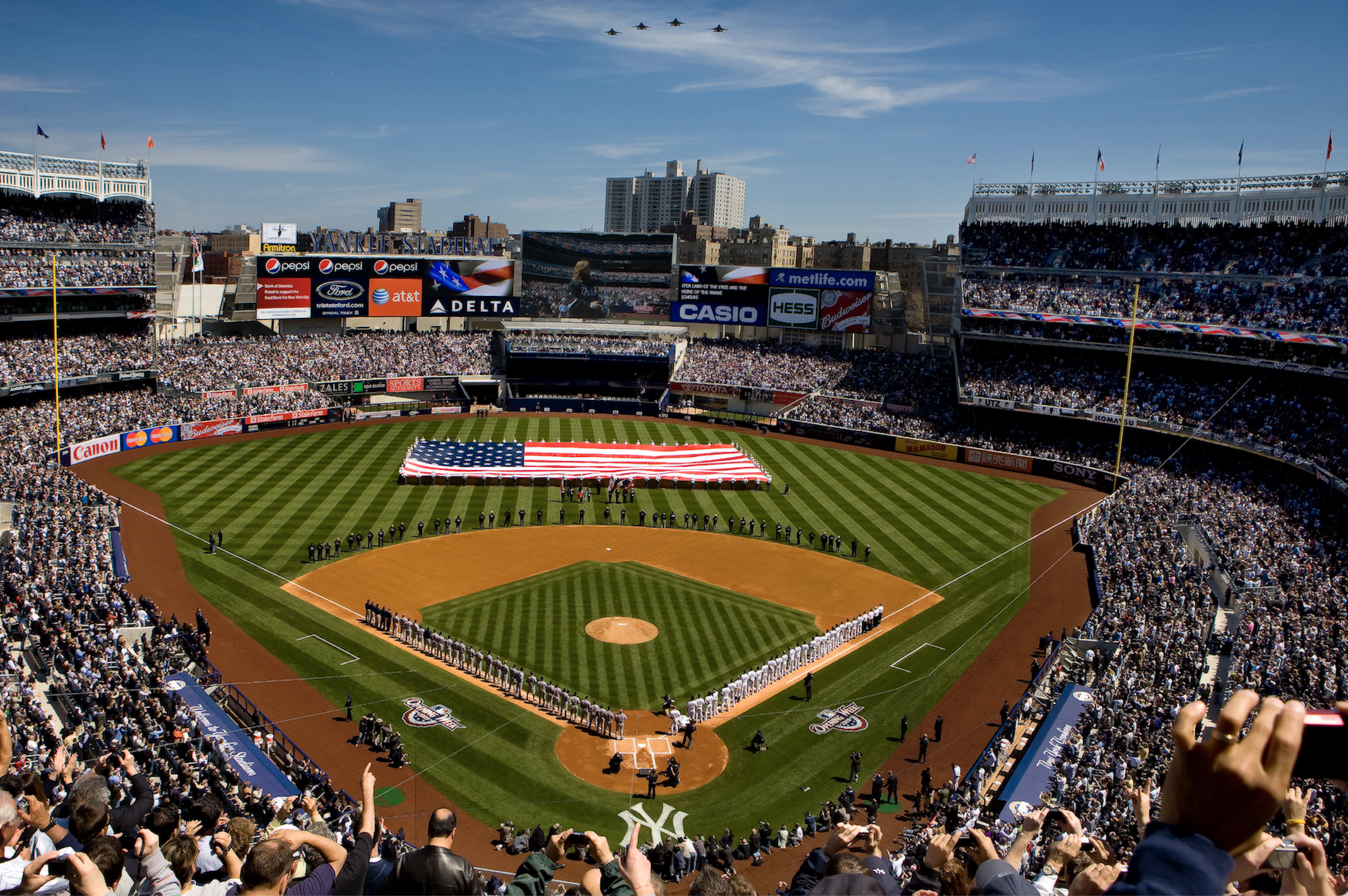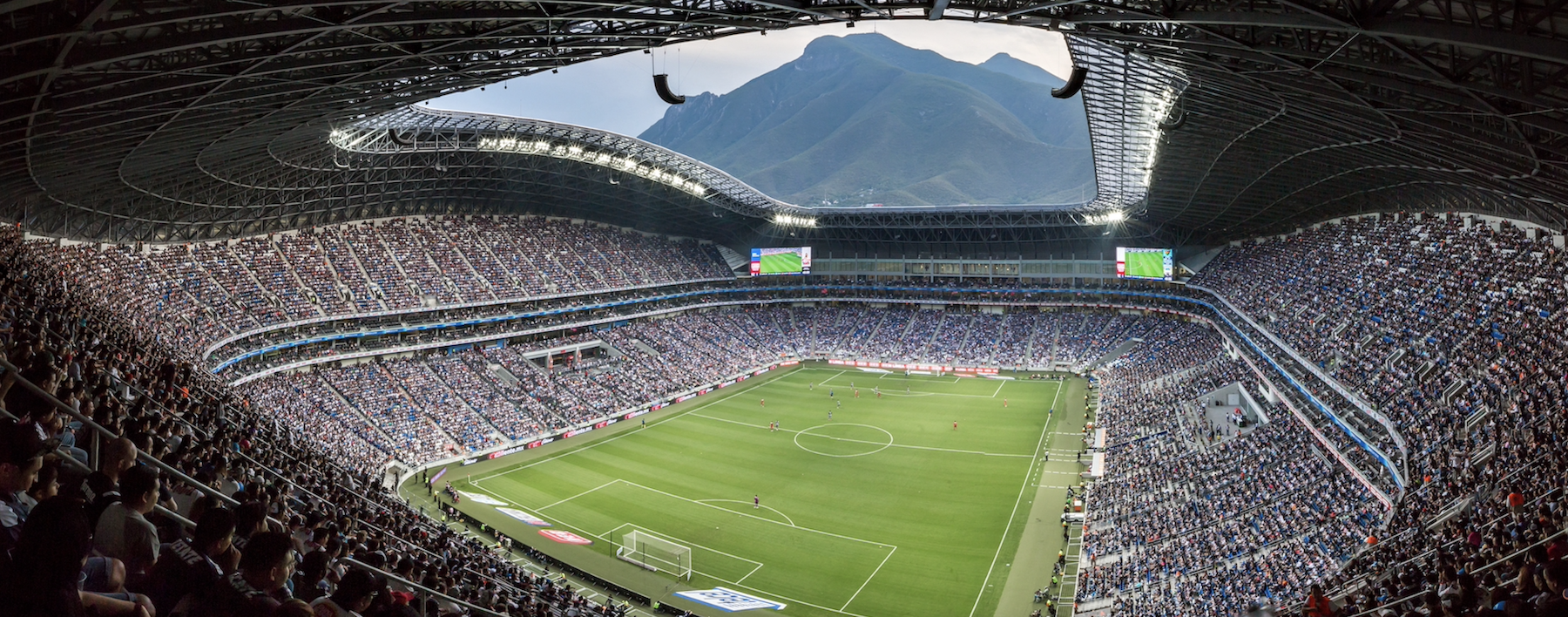When the architectural design firm Populous celebrated its 25th anniversary, it commemorated that landmark with a book of its projects. For its 40th anniversary this year, the firm wanted to do something more: to convey the excitement of fans who attended sporting and entertainment events in and around stadiums and arenas that Populous played a pivotal role in creating.
In partnership with Getty Images, Populous curated “Live Emotion,” an exhibit of striking photographs from Getty’s and Populous’ archives that focus on the firm’s work over the past four decades.
Sixty-one images in total were available to be mounted for the exhibit, which debuted at Noho Showrooms in London on November 25, and last weekend within 9,669 sf of gallery space on the first floor of The Starrett-Lehigh Building in New York. The exhibit, which has been open to the public, will also be shown in Brisbane, Australia.
(Click here to see the digital interactive gallery)
Photos trigger memories
The exhibit includes a diversity of photos of such well-known venues as O2 Arena and Wembley Stadium in London, Yankee Stadium in New York, the National Speed Skating Oval in Beijing, and the 132,000-seat Narendra Modi Cricket Stadium in Gujarat, India.
Earl Santee, Populous’ Global Chair and Founder, told BD+C that the motivation behind the exhibit was to “trigger” in its visitors at least a semblance of the personal emotions that sport events evoke in their fans. In fact, he pointed out how photography of sporting venues is more likely to focus on the athletes, performers, and fans than the building itself. That is even truer today, as many sports venues are being designed to be components of year-round destinations.
“We’ve always viewed our [sports and entertainment] buildings as mid-size convention centers,” quipped Scott Capstack, Populous’ Senior Principal and Design Director. Capstack and Santee also pointed out that some newer sports and entertainment venues can have as many as 20 to 25 “mini destinations” like restaurants, performance spaces, gift shops, and so forth, all with the potential for creating memories for visitors.



Related Stories
| Nov 29, 2010
Data Centers: Keeping Energy, Security in Check
Power consumption for data centers doubled from 2000 and 2006, and it is anticipated to double again by 2011, making these mission-critical facilities the nation’s largest commercial user of electric power. Major technology companies, notably Hewlett-Packard, Cisco Systems, and International Business Machines, are investing heavily in new data centers. HP, which acquired technology services provider EDS in 2008, announced in June that it would be closing many of its older data centers and would be building new, more highly optimized centers around the world.
| Nov 29, 2010
New Design Concepts for Elementary and Secondary Schools
Hard hit by the economy, new construction in the K-12 sector has slowed considerably over the past year. Yet innovation has continued, along with renovations and expansions. Today, Building Teams are showing a keener focus on sustainable design, as well as ways to improve indoor environmental quality (IEQ), daylighting, and low-maintenance finishes such as flooring.
| Nov 29, 2010
Renovating for Sustainability
Motivated by the prospect of increased property values, reduced utility bills, and an interest in jumping on the sustainability bandwagon, a noted upturn in green building upgrades is helping designers and real estate developers stay busy while waiting for the economy to recover. In fact, many of the larger property management outfits have set up teams to undertake projects seeking LEED for Existing Buildings: Operations & Maintenance (LEED-EBOM, also referred to as LEED-EB), a certification by the U.S. Green Building Council.
| Nov 23, 2010
The George W. Bush Presidential Center, which will house the former president’s library
The George W. Bush Presidential Center, which will house the former president’s library and museum, plus the Bush Institute, is aiming for LEED Platinum. The 226,565-sf center, located at Southern Methodist University, in Dallas, was designed by architect Robert A.M. Stern and landscape architect Michael Van Valkenburgh.
| Nov 23, 2010
Honeywell's School Energy and Environment Survey: 68% of districts delayed or eliminated improvements because of economy
Results of Honeywell's second annual “School Energy and Environment Survey” reveal that almost 90% of school leaders see a direct link between the quality and performance of school facilities, and student achievement. However, districts face several obstacles when it comes to keeping their buildings up to date and well maintained. For example, 68% of school districts have either delayed or eliminated building improvements in response to the economic downturn.
| Nov 16, 2010
Architecture Billings Index: inquiries for new projects remain extremely high
The new projects inquiry index was 61.7, down slightly from a nearly three-year high mark of 62.3 in September, according to the Architecture Billings Index (ABI). However, the ABI dropped nearly two points in October; the October ABI score was 48.7, down from a reading of 50.4 the previous month. The ABI reflects the approximate nine to 12 month lag time between architecture billings and construction spending.
| Nov 16, 2010
Brazil Olympics spurring green construction
Brazil's green building industry will expand in the coming years, spurred by construction of low-impact venues being built for the 2016 Olympics. The International Olympic Committee requires arenas built for the 2016 games in Rio de Janeiro meet international standards for low-carbon emissions and energy efficiency. This has boosted local interest in developing real estate with lower environmental impact than existing buildings. The timing couldn’t be better: the Brazilian government is just beginning its long-term infrastructure expansion program.
| Nov 16, 2010
Green building market grows 50% in two years; Green Outlook 2011 report
The U.S. green building market is up 50% from 2008 to 2010—from $42 billion to $55 billion-$71 billion, according to McGraw-Hill Construction's Green Outlook 2011: Green Trends Driving Growth report. Today, a third of all new nonresidential construction is green; in five years, nonresidential green building activity is expected to triple, representing $120 billion to $145 billion in new construction.
| Nov 16, 2010
Calculating office building performance? Yep, there’s an app for that
123 Zero build is a free tool for calculating the performance of a market-ready carbon-neutral office building design. The app estimates the discounted payback for constructing a zero emissions office building in any U.S. location, including the investment needed for photovoltaics to offset annual carbon emissions, payback calculations, estimated first costs for a highly energy efficient building, photovoltaic costs, discount rates, and user-specified fuel escalation rates.











